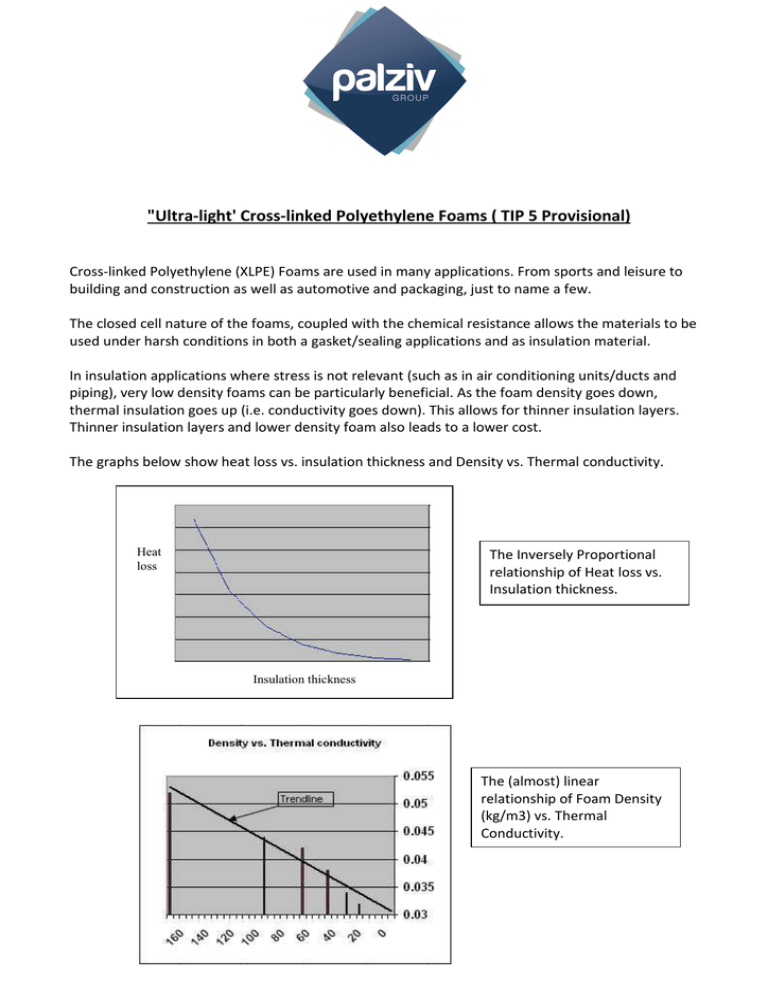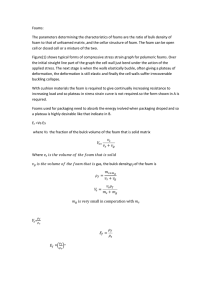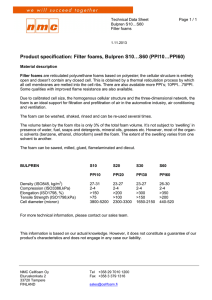Ultralight cross linked foam Cross
advertisement

"Ultra-light' Cross-linked Polyethylene Foams ( TIP 5 Provisional) Cross-linked Polyethylene (XLPE) Foams are used in many applications. From sports and leisure to building and construction as well as automotive and packaging, just to name a few. The closed cell nature of the foams, coupled with the chemical resistance allows the materials to be used under harsh conditions in both a gasket/sealing applications and as insulation material. In insulation applications where stress is not relevant (such as in air conditioning units/ducts and piping), very low density foams can be particularly beneficial. As the foam density goes down, thermal insulation goes up (i.e. conductivity goes down). This allows for thinner insulation layers. Thinner insulation layers and lower density foam also leads to a lower cost. The graphs below show heat loss vs. insulation thickness and Density vs. Thermal conductivity. Heat loss The Inversely Proportional relationship of Heat loss vs. Insulation thickness. Insulation thickness The (almost) linear relationship of Foam Density (kg/m3) vs. Thermal Conductivity. A New Development Up until recently, manufacturers of Cross-linked polyethylene foam( blown using a Chemical Blowing Agent) used in insulation applications, have not managed to make a stable, ultra low density foam (of 20kg/m3 /1.25PCF or less). Palziv's Galfoam Roll technology has allowed this situation to be remedied with a range of Ultra-light foams. Not only will lower conductivity values now be available, but a lower cost and the ability to attain thinner insulation thicknesses. Due to the extremely low density values, the lack of polymer material leads to quite weak foams. This in turn means that structural and heavy stress applications (such as underneath concrete floors) are not suitable for the Ultralight range. In non-stress thermal insulation situations (such as Air conditioning duct insulation or pipe insulation), this material is an excellent replacement for XLPE foams that have previously been used (of higher densities). GA20 and GA16 General Purpose light foam (20kg/m3 and 16kg/m3) (1.25PCF and 1PCF) Another interesting observation is with regards to the Fire Retardant performance of the Ultra-light materials. Due to the Ultra low density, the smaller amount of Polymer mass achieves low drip/self extinguishing/low smoke properties that can outperform more expensive, greater filled, higher density Fire Retardant foams. This allows the customer to benefit in almost every aspect. GA18FRIZ "Deca- DBE-Free" Fire retardant foams for pipe and Air conditioning duct insulation (18kg/m3/1.1PCF) Classified as UL94 HF-1 and Class1 (Italy) Ultra-light anti-static foams at sub-20kg/m3 (1.25PCF) foams for packaging applications give the standard 1 year anti-static performance at lower costs and with less mass waste. GA18AS for low stress Antistatic applications (18kg/m3 / 1.1PCF) As always, Palziv's R&D team is constantly improving the materials and performance of all ranges of the Cross-linked Polyethylene foams that are produced, be they Palfoam blocks or Galfoam rolls. Ein Hanatziv D.N Bet Shean 10805 Israel. Tel: 972 46062999 Fax: 972 46062958 Email: Contact@palziv.com


